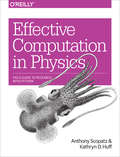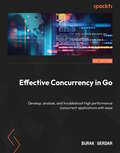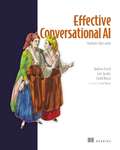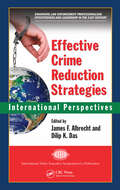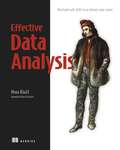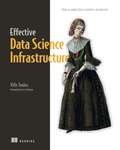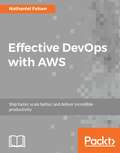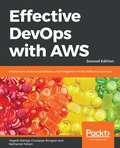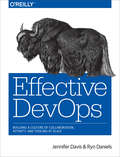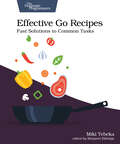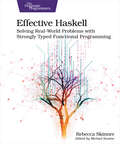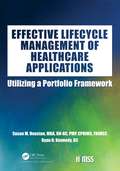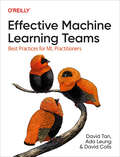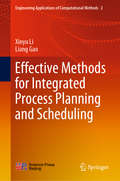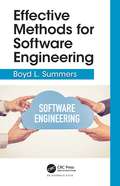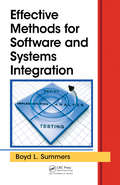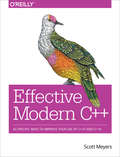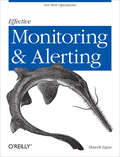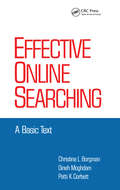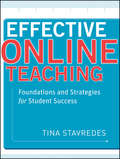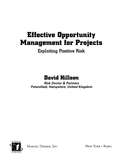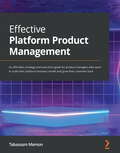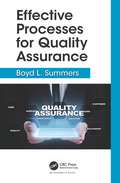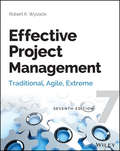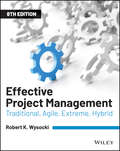- Table View
- List View
Effective Computation in Physics: Field Guide to Research with Python
by Kathryn D. Huff Anthony ScopatzMore physicists today are taking on the role of software developer as part of their research, but software development isnâ??t always easy or obvious, even for physicists. This practical book teaches essential software development skills to help you automate and accomplish nearly any aspect of research in a physics-based field.Written by two PhDs in nuclear engineering, this book includes practical examples drawn from a working knowledge of physics concepts. Youâ??ll learn how to use the Python programming language to perform everything from collecting and analyzing data to building software and publishing your results.In four parts, this book includes:Getting Started: Jump into Python, the command line, data containers, functions, flow control and logic, and classes and objectsGetting It Done: Learn about regular expressions, analysis and visualization, NumPy, storing data in files and HDF5, important data structures in physics, computing in parallel, and deploying softwareGetting It Right: Build pipelines and software, learn to use local and remote version control, and debug and test your codeGetting It Out There: Document your code, process and publish your findings, and collaborate efficiently; dive into software licenses, ownership, and copyright procedures
Effective Concurrency in Go: Develop, analyze, and troubleshoot high performance concurrent applications with ease
by Burak SerdarGain a deep understanding of concurrency and learn how to leverage concurrent algorithms to build high-throughput data processing applications, network servers and clients that scale.Key FeaturesLearn about the Go concurrency primitives, Go memory model, and common concurrency patternsDevelop the insights on how to model solutions to real-life problems using concurrencyExplore practical techniques to analyze how concurrent programs behaveBook DescriptionThe Go language has been gaining momentum due to its treatment of concurrency as a core language feature, making concurrent programming more accessible than ever. However, concurrency is still an inherently difficult skill to master, since it requires the development of the right mindset to decompose problems into concurrent components correctly. This book will guide you in deepening your understanding of concurrency and show you how to make the most of its advantages. You'll start by learning what guarantees are offered by the language when running concurrent programs. Through multiple examples, you will see how to use this information to develop concurrent algorithms that run without data races and complete successfully. You'll also find out all you need to know about multiple common concurrency patterns, such as worker pools, asynchronous pipelines, fan-in/fan-out, scheduling periodic or future tasks, and error and panic handling in goroutines. The central theme of this book is to give you, the developer, an understanding of why concurrent programs behave the way they do, and how they can be used to build correct programs that work the same way in all platforms. By the time you finish the final chapter, you'll be able to develop, analyze, and troubleshoot concurrent algorithms written in Go.What you will learnUnderstand basic concurrency concepts and problemsLearn about Go concurrency primitives and how they workLearn about the Go memory model and why it is importantUnderstand how to use common concurrency patternsSee how you can deal with errors in a concurrent programDiscover useful techniques for troubleshootingWho this book is forIf you are a developer with basic knowledge of Go and are looking to gain expertise in highly concurrent backend application development, then this book is for you. Intermediate Go developers who want to make their backend systems more robust and scalable will also find plenty of useful information. Prior exposure Go is a prerequisite.
Effective Conversational AI: Chatbots that work
by Andrew Freed Eniko Rozsa Cari JacobsCreate and improve conversational AI with the latest patterns, best practices, and tools, including generative AI models.Conversational AI (CAI) tools are built to solve problems, but all-too-often they just end up causing pain for users–and developers! Effective Conversational AI reveals best practices and industry-tested techniques for creating chatbots and conversational AI tools that are reliable at an enterprise scale. With the tested ideas and examples in this book, you&’ll learn to build chatbots that your customers and colleagues will actually want to use! In Effective Conversational AI you&’ll learn how to: • Create high-quality chatbots and other conversational AI experiences • Plan for continuous improvement • Incorporate generative AI solutions to improve quality, accuracy, and usability • Evaluate user experience and business results Effective Conversational AI introduces continuous improvement practices that are vital for the constant betterment and evolution of chatbots and CAI tools. It introduces the three most-common forms of chatbot—Q&A, process-oriented, and routing agents—and presents a reliable framework for continuously improving each one. Using modern generative AI and tried-and-tested classic approaches, you&’ll learn to deliver high performance chatbots that can guide a customer through complex end-to-end tasks—no human required! Foreword by Jesús Mantas. About the technology Powerful new chatbot frameworks and Generative AI models can practically eliminate problems like misinterpreting user intent and delivering nonsensical answers. In this book, you&’ll learn how to build chatbots that take advantage of large language models and other modern tools and create conversational AI experiences users will love. About the book Effective Conversational AI teaches you how to build great chatbots that perform reliably even at enterprise scale. In it, you&’ll learn how to clarify user intent using LLMs, respond accurately to unanticipated input, and use Retrieval Augmented Generation to keep responses up to date. Along the way, you&’ll discover how to establish a feedback loop for continuous quality improvement and master techniques to integrate GenAI safely into conventional chatbot designs. What's inside • Blend Generative AI and conventional chatbot tools • Use LLMs to improve quality, accuracy, and usability • Plan for continuous improvement • Domain-specific responses using RAG About the reader For developers, engineers, and product managers working with conversational AI. About the author Andrew Freed, Cari Jacobs, and Eniko Rózsa are seasoned conversational AI developers with IBM. Table of Contents Part 1 1 What makes conversational AI work? 2 Building a conversational AI 3 Planning for improvement Part 2 4 Understanding what your users really want 5 Improving weak understanding for traditional AI 6 Enhancing responses with retrieval-augmented generation 7 Augmenting intent data with generative AI Part 3 8 Streamlining complex flows 9 Harnessing context for an adaptive virtual assistant experience 10 Reducing complexity with generative AI Part 4 11 Reducing opt-outs 12 Conversational summarization for smooth handoff
Effective Crime Reduction Strategies: International Perspectives (International Police Executive Symposium Co-Publications)
by Dilip K. Das James F. AlbrechtThe International Police Executive Symposium (IPES, www.ipes.info) coordinates annual international conferences to evaluate critical issues in policing and recommend practical solutions to law enforcement executives deployed across the globe. Drawn from the 2005 proceedings hosted by the Czech Republic in Prague, Effective Crime Reduction Strategie
Effective Data Analysis: Hard and soft skills to accelerate your career
by Mona KhalilLearn the technical and soft skills you need to succeed in your career as a data analyst.You&’ve learned how to use Python, R, SQL, and the statistical skills needed to get started as a data analyst—so, what&’s next? Effective Data Analysis bridges the gap between foundational skills and real-world application. This book provides clear, actionable guidance on transforming business questions into impactful data projects, ensuring you&’re tracking the right metrics, and equipping you with a modern data analyst&’s essential toolbox. In Effective Data Analysis, you&’ll gain the skills needed to excel as a data analyst, including: • Maximizing the impact of your analytics projects and deliverables • Identifying and leveraging data sources to enhance organizational insights • Mastering statistical tests, understanding their strengths, limitations, and when to use them • Overcoming the challenges and caveats at every stage of an analytics project • Applying your expertise across a variety of domains with confidence Effective Data Analysis is full of sage advice on how to be an effective data analyst in a real production environment. Inside, you&’ll find methods that enhance the value of your work—from choosing the right analysis approach, to developing a data-informed organizational culture. Foreword by Barry McCardel. About the technology Data analysts need top-notch knowledge of statistics and programming. They also need to manage clueless stakeholders, navigate messy problems, and advocate for resources. This unique book covers the essential technical topics and soft skills you need to be effective in the real world. About the book Effective Data Analysis helps you lock down those skills along with unfiltered insight into what the job really looks like. You&’ll build out your technical toolbox with tips for defining metrics, testing code, automation, sourcing data, and more. Along the way, you&’ll learn to handle the human side of data analysis, including how to turn vague requirements into efficient data pipelines. And you&’re sure to love author Mona Khalil&’s illustrations, industry examples, and a friendly writing style. What's inside • Identify and incorporate external data • Communicate with non-technical stakeholders • Apply and interpret statistical tests • Techniques to approach any business problem About the reader Written for early-career data analysts, but useful for all. About the author Mona Khalil is the Senior Manager of Analytics Engineering at Justworks. Table of Contents Part 1 1 What does an analyst do? 2 From question to deliverable 3 Testing and evaluating hypotheses Part 2 4 Statistics you (probably) learned: T-tests, ANOVAs, and correlations 5 Statistics you (probably) missed: Non-parametrics and interpretation 6 Are you measuring what you think you&’re measuring? 7 The art of metrics: Tracking performance for organizational success Part 3 8 Navigating sensitive and protected data 9 The world of statistical modeling 10 Incorporating external data into analyses 11 The magic of well-structured data 12 Tools and tech for modern data analytics
Effective Data Science Infrastructure: How to make data scientists productive
by Ville TuulosSimplify data science infrastructure to give data scientists an efficient path from prototype to production.In Effective Data Science Infrastructure you will learn how to: Design data science infrastructure that boosts productivity Handle compute and orchestration in the cloud Deploy machine learning to production Monitor and manage performance and results Combine cloud-based tools into a cohesive data science environment Develop reproducible data science projects using Metaflow, Conda, and Docker Architect complex applications for multiple teams and large datasets Customize and grow data science infrastructure Effective Data Science Infrastructure: How to make data scientists more productive is a hands-on guide to assembling infrastructure for data science and machine learning applications. It reveals the processes used at Netflix and other data-driven companies to manage their cutting edge data infrastructure. In it, you&’ll master scalable techniques for data storage, computation, experiment tracking, and orchestration that are relevant to companies of all shapes and sizes. You&’ll learn how you can make data scientists more productive with your existing cloud infrastructure, a stack of open source software, and idiomatic Python. The author is donating proceeds from this book to charities that support women and underrepresented groups in data science. About the technology Growing data science projects from prototype to production requires reliable infrastructure. Using the powerful new techniques and tooling in this book, you can stand up an infrastructure stack that will scale with any organization, from startups to the largest enterprises. About the book Effective Data Science Infrastructure teaches you to build data pipelines and project workflows that will supercharge data scientists and their projects. Based on state-of-the-art tools and concepts that power data operations of Netflix, this book introduces a customizable cloud-based approach to model development and MLOps that you can easily adapt to your company&’s specific needs. As you roll out these practical processes, your teams will produce better and faster results when applying data science and machine learning to a wide array of business problems. What's inside Handle compute and orchestration in the cloud Combine cloud-based tools into a cohesive data science environment Develop reproducible data science projects using Metaflow, AWS, and the Python data ecosystem Architect complex applications that require large datasets and models, and a team of data scientists About the reader For infrastructure engineers and engineering-minded data scientists who are familiar with Python. About the author At Netflix, Ville Tuulos designed and built Metaflow, a full-stack framework for data science. Currently, he is the CEO of a startup focusing on data science infrastructure. Table of Contents 1 Introducing data science infrastructure 2 The toolchain of data science 3 Introducing Metaflow 4 Scaling with the compute layer 5 Practicing scalability and performance 6 Going to production 7 Processing data 8 Using and operating models 9 Machine learning with the full stack
Effective DevOps with AWS: Implement Continuous Delivery And Integration In The Aws Environment, 2nd Edition
by Nathaniel FelsenScale gracefully and maintain outstanding performance with your AWS-based infrastructure using DevOps principles About This Book • Implement DevOps principles to take full advantage of the AWS stack and services • Take expert look at solving problems faced by real developers and operation teams and learn to overcome them • Learn from expert insights of the author who has worked with Silicon Valley's most high-profile companies Who This Book Is For This book is for developers, DevOps engineers and teams who want to build and use AWS for their software infrastructure. Basic computer science knowledge is required for this book. What You Will Learn • Find out what it means to practice DevOps and what its principles are • Build repeatable infrastructures using templates and configuration management • Deploy multiple times a day by implementing continuous integration and continuous deployment pipelines • Use the latest technologies, including containers and serverless computing, to scale your infrastructure • Collect metrics and logs and implement an alerting strategy • Make your system robust and secure In Detail The DevOps movement has transformed the way modern tech companies work. AWS which has been on the forefront of the Cloud computing revolution has also been a key contributor of this DevOps movement creating a huge range of managed services that help you implement the DevOps principles. In this book, you'll see how the most successful tech start-ups launch and scale their services on AWS and how you can too. Written by a lead member of Mediums DevOps team, this book explains how to treat infrastructure as code, meaning you can bring resources online and offline as necessary with the code as easily as you control your software. You will also build a continuous integration and continuous deployment pipeline to keep your app up to date. You'll find out how to scale your applications to offer maximum performance to users anywhere in the world, even when traffic spikes with the latest technologies, such as containers and serverless computing. You will also take a deep dive into monitoring and alerting to make sure your users have the best experience when using your service. Finally, you'll get to grips with ensuring the security of your platform and data. Style and approach This is a practical, hands-on, comprehensive guide to AWS, helping readers understand AWS in a step by step manner.
Effective DevOps with AWS: Implement continuous delivery and integration in the AWS environment, 2nd Edition
by Nathaniel Felsen Yogesh Raheja Giuseppe BorgeseScale and maintain outstanding performance in your AWS-based infrastructure using DevOps principlesKey FeaturesImplement continuous integration and continuous deployment pipelines on AWSGain insight from an expert who has worked with Silicon Valley's most high-profile companiesImplement DevOps principles to take full advantage of the AWS stack and servicesBook DescriptionThe DevOps movement has transformed the way modern tech companies work. Amazon Web Services (AWS), which has been at the forefront of the cloud computing revolution, has also been a key contributor to the DevOps movement, creating a huge range of managed services that help you implement DevOps principles.Effective DevOps with AWS, Second Edition will help you to understand how the most successful tech start-ups launch and scale their services on AWS, and will teach you how you can do the same. This book explains how to treat infrastructure as code, meaning you can bring resources online and offline as easily as you control your software. You will also build a continuous integration and continuous deployment pipeline to keep your app up to date. Once you have gotten to grips will all this, we'll move on to how to scale your applications to offer maximum performance to users even when traffic spikes, by using the latest technologies, such as containers. In addition to this, you'll get insights into monitoring and alerting, so you can make sure your users have the best experience when using your service. In the concluding chapters, we'll cover inbuilt AWS tools such as CodeDeploy and CloudFormation, which are used by many AWS administrators to perform DevOps. By the end of this book, you'll have learned how to ensure the security of your platform and data, using the latest and most prominent AWS tools.What you will learnImplement automatic AWS instance provisioning using CloudFormationDeploy your application on a provisioned infrastructure with AnsibleManage infrastructure using TerraformBuild and deploy a CI/CD pipeline with Automated Testing on AWSUnderstand the container journey for a CI/CD pipeline using AWS ECSMonitor and secure your AWS environmentWho this book is forEffective DevOps with AWS is for you if you are a developer, DevOps engineer, or you work in a team which wants to build and use AWS for software infrastructure. Basic computer science knowledge is required to get the most out of this book.
Effective DevOps: Building a Culture of Collaboration, Affinity, and Tooling at Scale
by Jennifer Davis Ryn DanielsSome companies think that adopting devops means bringing in specialists or a host of new tools. With this practical guide, you’ll learn why devops is a professional and cultural movement that calls for change from inside your organization. Authors Ryn Daniels and Jennifer Davis provide several approaches for improving collaboration within teams, creating affinity among teams, promoting efficient tool usage in your company, and scaling up what works throughout your organization’s inflection points.Devops stresses iterative efforts to break down information silos, monitor relationships, and repair misunderstandings that arise between and within teams in your organization. By applying the actionable strategies in this book, you can make sustainable changes in your environment regardless of your level within your organization.Explore the foundations of devops and learn the four pillars of effective devopsEncourage collaboration to help individuals work together and build durable and long-lasting relationshipsCreate affinity among teams while balancing differing goals or metricsAccelerate cultural direction by selecting tools and workflows that complement your organizationTroubleshoot common problems and misunderstandings that can arise throughout the organizational lifecycleLearn from case studies from organizations and individuals to help inform your own devops journey
Effective Go Recipes
by Miki TebekaProgrammers love Go because it is lightweight, easy to work with, and easy to read. Go gives you the benefits of dynamically typed languages (speed of development) while keeping the upsides of strongly typed languages (security and performance). Go is a simple language, but programming in Go is about more than just mastering syntax. There's an art to using Go effectively. Squeeze out the full use of advanced networking and multi-core power for which Go was designed. Save precious coding hours with recipes that help you manage objects, collect garbage, and safely use memory. Tackle Unicode, concurrency, and serialization with ease. All the clean, reusable solutions you need for a wide variety of problems common to Go development. Outfitted with these recipes, your next apps will be more polished and more maintainable than ever. Start out by tackling time and see how the Go time packager provides types that will do most of the heavy lifting for you. Next, work on recipes tailored to the nuances of processing text, like normalizing strings to avoid bugs. From there, whip up some functions on-the-fly and store functions in variables and data structures. Ever wondered why Go seems to be peppered with error handling? Working through the next recipes, you'll discover the benefits, which include more robust code. In the section on HTTP, you'll learn tricks like running multiple HTTP servers on the same port and setting timeouts. With concurrency recipes, you'll limit the number of goroutines to improve performance, give your code awareness of timeouts, and decide when to keep your code sequential instead of making it concurrent. Throughout the book, you'll make Go sizzle following simple recipes and tweaking them to fit your own apps. Using tools like strong typing and concurrency primitives, build a Go codebase that stays maintainable at scale.What You Need:You should know the Go language syntax and have some experience in programming.You will need a Go SDK, a Git client, and for some of the chapters, a C compiler.
Effective Haskell
by Rebecca SkinnerPut the power of Haskell to work in your programs, learning from an engineer who uses Haskell daily to get practical work done efficiently. Leverage powerful features like Monad Transformers and Type Families to build useful applications. Realize the benefits of a pure functional language, like protecting your code from side effects. Manage concurrent processes fearlessly. Apply functional techniques to working with databases and building RESTful services. Don't get bogged down in theory, but learn to employ advanced programming concepts to solve real-world problems. Don't just learn the syntax, but dive deeply into Haskell as you build efficient, well-tested programs. Haskell is a pure functional programming language with a rich ecosystem of tools and libraries. Designed to push the boundaries of programming, it offers unparalleled power for building reliable and maintainable systems. But to unleash that power, you need a guide. Effective Haskell is that guide. Written by an engineer who understands how to apply Haskell to the real world and uses it daily to get practical work done, it is your ticket to Haskell mastery.Gain deep understanding of how Haskell deals with IO and the outside world by writing a complete Haskell application that does several different kinds of IO. Reinforce your learnings with practice exercises in every chapter.Write stable and performant code using Haskell's type system, code that is easier to grow and refactor. Leverage the power of pure functional programming to improve collaboration, make concurrency safe and easy, and make large code bases manageable.Implement type-safe web services, write generative tests, design strongly typed embedded domain-specific languages, and build applications that exploit parallelism and concurrency without fear of deadlocks and race conditions. Create and deploy cloud-native Haskell applications. Master the performance characteristics of functional applications to make them run faster and use less memory.Write Haskell programs that solve real-world business problems.What You Need:Intel based Mac, M1 Macs, Linux PC, or Windows with WSL2ghcup (http://www. Haskell.org/ghcup/)An active internet connection will be required for some projects.
Effective Lifecycle Management of Healthcare Applications: Utilizing a Portfolio Framework (HIMSS Book Series)
by Susan M. Houston Ryan D. KennedyThe rapid growth of software applications within healthcare organizations has made it essential to have defined methodologies and formal processes for the management of the entire Information Technology (IT) portfolio. Utilizing a portfolio management framework throughout an application’s lifecycle will provide the necessary structure to ensure that all new applications are properly evaluated, and, once implemented, remain relevant while continuing to meet organizational requirements. While an organization may have a few large "organization-wide" systems such as the Electronic Health Record (EHR), lab or radiology systems, they also have a large quantity of other clinical, administrative, and research systems. Some larger organizations now have hundreds of software applications to support and manage. The IT staff must be able to implement new requests while still maintaining the current application portfolio. Utilizing a standard repeatable process will help to manage these large portfolios of software applications. This book reviews the management of applications throughout their lifecycle, from initial request through disposition. Best practices dictate that every newly requested application undergoes analysis followed by an approval decision from the organization’s governance committee. The initial implementation project must include activities to prepare for ongoing support while ensuring the application is compliant with all security, privacy, and architecture requirements. An application spends years in operations and maintenance where changes occur regularly through configuration and release management, or additional projects. The cycle continues until disposition. Understanding when to dispose of an application is just as important as deciding when to implement a new one. A defined process for disposing of an application ensures all parts are properly removed or destroyed.
Effective Machine Learning Teams: Best Practices for ML Practitioners
by David Tan Ada Leung David CollsGain the valuable skills and techniques you need to accelerate the delivery of machine learning solutions. With this practical guide, data scientists, ML engineers, and their leaders will learn how to bridge the gap between data science and Lean product delivery in a practical and simple way. David Tan, Ada Leung, and Dave Colls show you how to apply time-tested software engineering skills and Lean product delivery practices to reduce toil and waste, shorten feedback loops, and improve your team's flow when building ML systems and products.Based on the authors' experience across multiple real-world data and ML projects, the proven techniques in this book will help your team avoid common traps in the ML world, so you can iterate and scale more quickly and reliably. You'll learn how to overcome friction and experience flow when delivering ML solutions.You'll also learn how to:Write automated tests for ML systems, containerize development environments, and refactor problematic codebasesApply MLOps and CI/CD practices to accelerate experimentation cycles and improve reliability of ML solutionsApply Lean delivery and product practices to improve your odds of building the right product for your usersIdentify suitable team structures and intra- and inter-team collaboration techniques to enable fast flow, reduce cognitive load, and scale ML within your organization
Effective Methods for Integrated Process Planning and Scheduling (Engineering Applications of Computational Methods #2)
by Liang Gao Xinyu LiThis book summarizes a series of research work on integrated process planning and scheduling (IPPS) done by the authors, focusing on discussing the properties, novel solution methods and applications of process planning, scheduling and IPPS problems under different machining environments. It is a valuable reference resource for teachers, students and researchers working in the fields of engineering, management science and other related disciplines.
Effective Methods for Software Engineering
by Boyd L. SummersSoftware is important because it is used by a great many people in companies and institutions. This book presents engineering methods for designing and building software. Based on the author’s experience in software engineering as a programmer in the defense and aerospace industries, this book explains how to ensure a software that is programmed operates according to its requirements. It also shows how to develop, operate, and maintain software engineering capabilities by instilling an engineering discipline to support programming, design, builds, and delivery to customers. This book helps software engineers to: Understand the basic concepts, standards, and requirements of software engineering. Select the appropriate programming and design techniques. Effectively use software engineering tools and applications. Create specifications to comply with the software standards and requirements. Utilize various methods and techniques to identify defects. Manage changes to standards and requirements. Besides providing a technical view, this book discusses the moral and ethical responsibility of software engineers to ensure that the software they design and program does not cause serious problems. Software engineers tend to be concerned with the technical elegance of their software products and tools, whereas customers tend to be concerned only with whether a software product meets their needs and is easy and ready to use. This book looks at these two sides of software development and the challenges they present for software engineering. A critical understanding of software engineering empowers developers to choose the right methods for achieving effective results. Effective Methods for Software Engineering guides software programmers and developers to develop this critical understanding that is so crucial in today’s software-dependent society.
Effective Methods for Software and Systems Integration
by Boyd L. SummersBefore software engineering builds and installations can be implemented into software and/or systems integrations in military and aerospace programs, a comprehensive understanding of the software development life cycle is required. Covering all the development life cycle disciplines, Effective Methods for Software and Systems Integration explains h
Effective Modern C++: 42 Specific Ways to Improve Your Use of C++11 and C++14
by Scott MeyersComing to grips with C++11 and C++14 is more than a matter of familiarizing yourself with the features they introduce (e.g., auto type declarations, move semantics, lambda expressions, and concurrency support). The challenge is learning to use those features effectively—so that your software is correct, efficient, maintainable, and portable. That’s where this practical book comes in. It describes how to write truly great software using C++11 and C++14—i.e. using modern C++.Topics include:The pros and cons of braced initialization, noexcept specifications, perfect forwarding, and smart pointer make functionsThe relationships among std::move, std::forward, rvalue references, and universal referencesTechniques for writing clear, correct, effective lambda expressionsHow std::atomic differs from volatile, how each should be used, and how they relate to C++'s concurrency APIHow best practices in "old" C++ programming (i.e., C++98) require revision for software development in modern C++Effective Modern C++ follows the proven guideline-based, example-driven format of Scott Meyers' earlier books, but covers entirely new material."After I learned the C++ basics, I then learned how to use C++ in production code from Meyer's series of Effective C++ books. Effective Modern C++ is the most important how-to book for advice on key guidelines, styles, and idioms to use modern C++ effectively and well. Don't own it yet? Buy this one. Now".-- Herb Sutter, Chair of ISO C++ Standards Committee and C++ Software Architect at Microsoft
Effective Monitoring and Alerting: For Web Operations
by Slawek LigusWith this practical book, you’ll discover how to catch complications in your distributed system before they develop into costly problems. Based on his extensive experience in systems ops at large technology companies, author Slawek Ligus describes an effective data-driven approach for monitoring and alerting that enables you to maintain high availability and deliver a high quality of service.Learn methods for measuring state changes and data flow in your system, and set up alerts to help you recover quickly from problems when they do arise. If you’re a system operator waging the daily battle to provide the best performance at the lowest cost, this book is for you.Monitor every component of your application stack, from the network to user experienceLearn how to draw the right conclusions from the metrics you obtainDevelop a robust alerting system that can identify problematic anomalies—without raising false alarmsAddress system failures by their impact on resource utilization and user experiencePlan an alerting configuration that scales with your expanding networkLearn how to choose appropriate maintenance times automaticallyDevelop a work environment that fosters flexibility and adaptability
Effective Online Searching: A Basic Text
by Christine L. Borgman Dineh Moghdam Patti K. CorbettThis book focuses on searching and hands-on experience, which makes the text suitable for those who wish to learn searching for their own use as well. It is intended for those who will act as search intermediaries, accepting questions from clients and performing the searches.
Effective Online Teaching
by Tina StavredesIn order to enable the widespread adoption of online education, faculty must be trained in the pedagogy of teaching in this medium. This book offers an understanding of how cognition and learning theory applies to an online learning environment. Through behaviorist, constructivist, and cognitive approaches it provides strategies for incorporating this knowledge into effective learner-centered teaching practice. Each chapter contains reflection and discussion questions which can be used for self-directed learning. It is ideal for new instructors or those new to online teaching.
Effective Opportunity Management for Projects: Exploiting Positive Risk (Pm Solutions Research Ser. #Vol. 6)
by David HillsonWith step-by-step guidelines, this bestselling reference discusses the management of project opportunities by expanding the traditional risk management process to address opportunities alongside threats. It offers valuable tools and techniques that expose and capture opportunities, minimize threats, and deal with all types of uncertainty in your business and projects. Written by an experienced consultant and risk management specialist, this guide emphasizes that risk processes must cover both opportunities and threats if they are to assist in accomplishing project objectives and maximizing business benefits.
Effective Platform Product Management: A product manager's guide to strategizing and executing the platform business model to expand the customer base
by Tabassum MemonDesign, strategize, and implement a proven roadmap for your platforms to scale your business across multiple channels that provide a seamless and intuitive user experienceKey FeaturesUnderstand the importance of platform business models and the difference between linear products and platformsExplore the end-to-end platform life cycle, from developing a strategy to measuring the outcomeDiscover the benefits of the platform business model and effective strategies through examplesBook DescriptionIn recent years, platform business models have revolutionized various industries, including retail and media. Companies such as Amazon, Netflix, and Spotify have changed how businesses reach out to their consumers. With the rise of these platforms and the increased use of technology, consumers prefer to search, explore, compare, and choose between different options within a single uninterrupted user experience. Providing such an experience is difficult and almost impossible when using linear models, and this is why modern businesses must adopt a platform-first approach to change how they invent, develop, and market solutions. This book addresses a critical pillar of platform development – product management. It'll help you to understand the difference between traditional and modern product management for platforms while exploring the importance and benefits of the platform business model. As you progress, you'll be able to build the right platform strategy, define the MVP, and focus on ongoing backlog prioritization for successful platforms. This book also walks you through the steps and guidelines that'll help organizations and product managers to transition from linear products to platforms. By the end of this platform product management book, you'll have learned the essential aspects of product management for building successful and scalable platforms.What you will learnUnderstand the difference between the product and platform business modelBuild an end-to-end platform strategy from scratchTranslate the platform strategy to a roadmap with a well-defined implementation planDefine the MVP for faster releases and test viability in the early stagesCreate an operating model and design an execution planMeasure the success or failure of the platform and make iterations after feedbackWho this book is forThis book is for product managers, product owners, product directors, and business executives responsible for defining platform strategy and its day-to-day execution. The book will also be useful for change managers and program managers who are responsible for the transition from products to platforms. No prior knowledge of platform strategy or platform transitioning is required as the book covers these topics to help you get started.
Effective Processes for Quality Assurance
by Boyd L. SummersDriving innovation can reduce costs for companies, institutions, military programs, and successful businesses. Quality is key to successful innovation. Delivery of complex products must have high quality to reduce customer problems and defects. This book explains how to integrate Quality Assurance processes to produce compliant product management and gap analysis. It shows how Quality Assurance provides a common operating framework in which best practices, improvements, and cost avoidance activities can be shared. Effective Processes for Quality Assurance emphasizes improving process execution and reducing operational costs. It also focuses on how Quality Assurance personnel must support companies, institutions, military programs, and successful businesses by encouraging a cooperative, proactive approach and ensure compliance through management and team member participation. Lean and Agile can provide a competitive advantage, and this practical reference explains how to implement these two principles to deliver products that have fewer defects. It also explains: Quality Assurance methods Measuring benefits of Quality Assurance process improvement Quality Assurance performance and improvement Risk management Quality Assurance improvement with metrics Effective processes for Quality Assurance Quantitative process performance and commitments Quality Assurance plans Quality Assurance for customers and suppliers Supporting software configuration Effective Processes for Quality Assurance covers the critical issues for implementing Quality Assurance processes that can deliver high-quality products successfully.
Effective Project Management
by Robert K. WysockiUnlock your potential and achieve breakthrough performance in project managementIf you're looking for a more robust approach to project management--one that recognizes the project environment and adapts accordingly--then this is the perfect resource. It not only guides you through the traditional methods, but also covers the adaptive and extreme approaches as well. You'll gain an in-depth understanding of each one and know exactly when and how to use them.You'll also be introduced to the Adaptive Project Framework, which arms you with a new project management methodology. And with the help of two new case studies, you'll be able to put these ideas into practice and experience some of the contemporary nuances of projects.This definitive guide to project management shows you how to:Take advantage of new variations on traditional project management methods, including risk assessment and controlDecide the best method for managing specific types of projects by analyzing all of the pros and consApply the Adaptive Project Framework to the world of fast-paced, high-change, and complex projectsCreate a war room to successfully manage multiple team projectsDetermine how project portfolio management approaches can help companies achieve a greater return on investmentUtilize all nine Project Management Body of Knowledge (PMBOK) standards advocated by the Project Management Institute (PMI)
Effective Project Management: Traditional, Agile, Extreme, Hybrid
by Robert K. WysockiThe popular guide to the project management body of knowledge, now fully updated Now in its seventh edition, this comprehensive guide to project management has long been considered the standard for both professionals and academics, with nearly 40,000 copies sold in the last three editions! Well-known expert Robert Wysocki has added four chapters of new content based on instructor feedback, enhancing the coverage of best-of-breed methods and tools for ensuring project management success. With enriched case studies, accompanying exercises and solutions on the companion website, and PowerPoint slides for all figures and tables, the book is ideal for instructors and students as well as active project managers. Serves as a comprehensive guide to project management for both educators and project management professionals Updated to cover the new PMBOK® Sixth Edition Examines traditional, agile, and extreme project management techniques; the Enterprise Project Management Model; and Kanban and Scrumban methodologies Includes a companion website with exercises and solutions and well as PowerPoint slides for all the figures and tables used Written by well-known project management expert Robert Wysocki Effective Project Management, Eighth Edition remains the comprehensive resource for project management practitioners, instructors, and students.(PMBOK is a registered mark of the Project Management Institute, Inc.)
